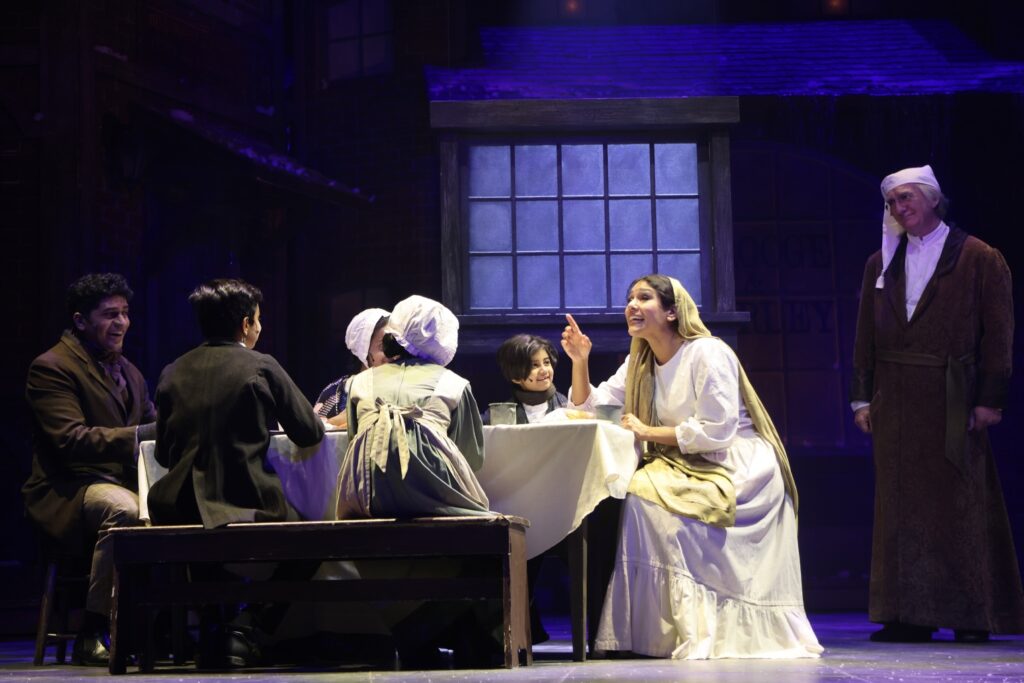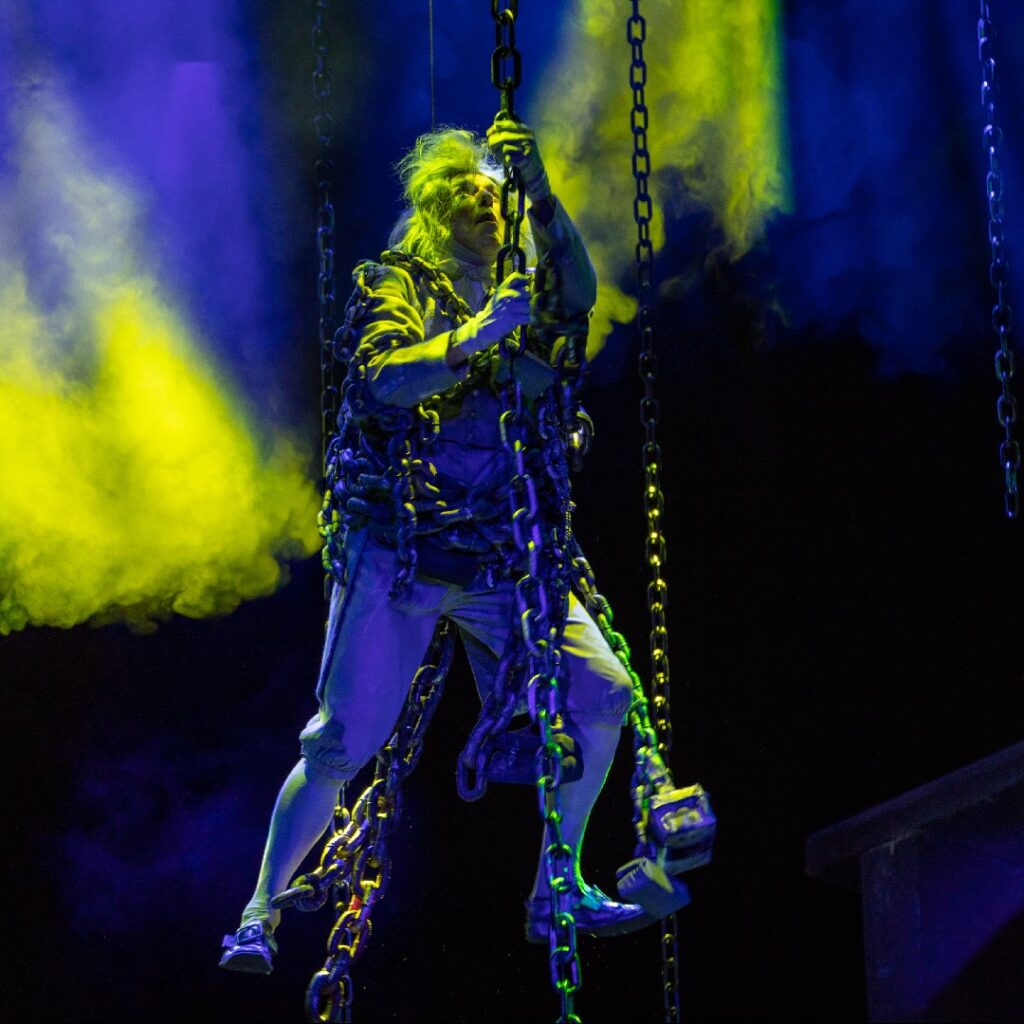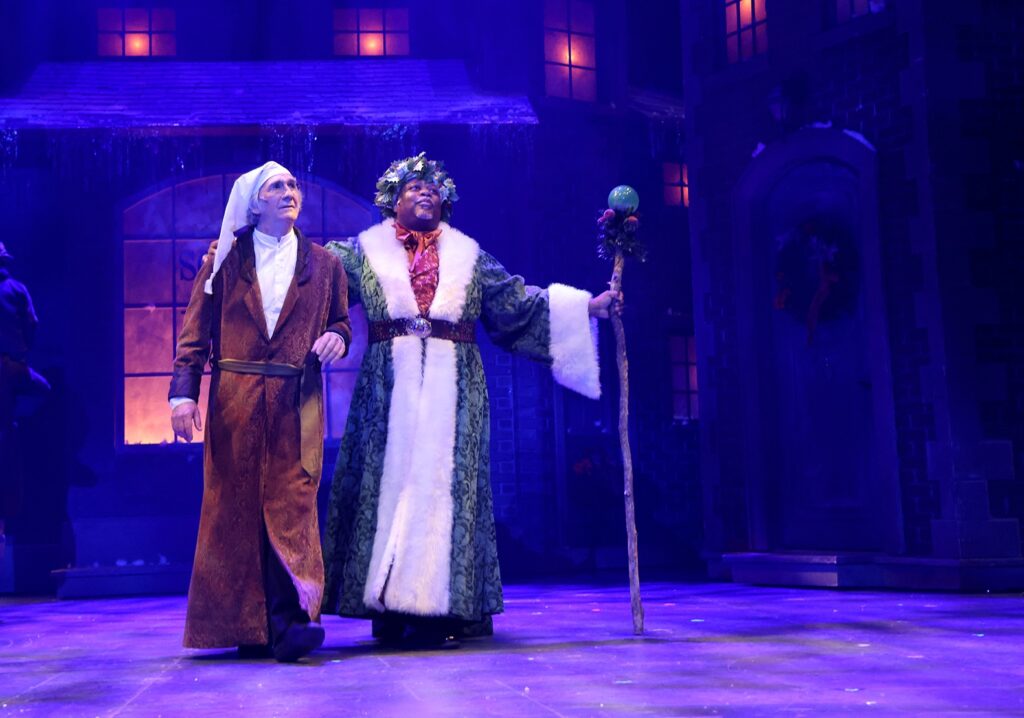
by Mike Hoban
With so many different takes on the iconic Dickens holiday classic, “A Christmas Carol” over the years – from the 1938 Alistair Sim movie to the surprisingly accurate 1962 Mr. Magoo cartoon to the well-intentioned but heavy-handed progressive versions now appearing on some New England stages – the production now underway at the Hanover Theatre in Worcester is a welcome return to the original story, but one that also reflects the diversity of today’s society and audiences. Faithfully adapted by director Troy Siebels, this version brings us back to the streets of Victorian England, where income inequality and the attitudes of the moneyed class towards the working poor will look all too familiar.
As the story opens, we see the joy that the Christmas season is bringing to the streets of London – for everyone but the miserable Scrooge, of course – as he brushes aside the great unwashed on his way to the Scrooge & Marley counting house. There, we meet his faithful but undervalued assistant Bob Cratchit, who is nearly fired for attempting to add a lump of coal to the stove to warm up the frigid office. We also see that his callousness towards humanity extends well past simply degrading employees. When two men come to Scrooge’s office to solicit funds for the disadvantaged, we hear Mr. Scrooge’s views on the less fortunate (“If they would rather die, then they had better do it, and decrease the surplus population”) and we know we’re dealing with someone who considers being called “cold-hearted” a compliment.

Scrooge’s journey into humanity begins with a ghostly encounter with his old business partner, the seven-years dead Jacob Marley, who “wears the chain I forged in life” and hopes to prevent Scrooge from a similar fate. The apparition soon has him cowering in the corner, seeking mercy. And with good reason. This Marley would be the premier attraction in any Halloween haunted house. Made up like a green goblin and soaring across the expansive stage, he screeches like a banshee at Scrooge to drive home his message, which essentially boils down to this lesson that Scrooge must learn: “Mankind was my business,” Marley bellows to his old partner. “The common welfare was my business; charity, mercy, forbearance, and benevolence were all my business. The dealings of my trade were but a drop of water in the comprehensive ocean of my business!!!!” So under the threat of eternal suffering, Scrooge reluctantly accedes, and the painful healing process begins, courtesy of a trio of the spirits of Christmases Past, Present and the (truly frightening) Yet To Come.
Director Siebels cleverly uses members of the ensemble as narrators to advance the plot (Boston theatergoers may recognize Mark Linehan and Brad Reinking as featured players), including a grown-up Tiny Tim, and it works well in terms of keeping the original story intact. John Little brings the goods as an effective Scrooge, both as the mean-spirited sociopath terrorizing match girls and threatening to ruin street vendors for late payments, as well as his warm characterization of the reformed Scrooge – which is no easy task with such a wild swing in character.

Siebels uses non-traditional casting effectively by re-imagining the Cratchit family as a South Asian family of Indian origin, with Sriram Emani and Alka Nayyar returning to their roles as Mr. and Mrs. Cratchit. Given the colonizing of India by the British government and the fact that many Indians suffered from extreme poverty and famines during British rule, the diverse casting makes perfect sense (although the chanting of a Hindi prayer during the Christmas dinner did seem to be a bit incongruent). Another way Siebels successfully diversifies the classic comes viaTye Roberson’s entertaining portrayal of the “Ghost of Christmas Present”, who uses his booming, Jamaican-accented pipes to great effect. The cast is uniformly solid, with Tyler Bellmon and Emani giving particularly effervescent performances as Scrooge’s nephew Fred and Bob Cratchit, respectively.
Kudos also to Boston favorite (and Worcester native) Ilyse Robbins, not only for her choreography of the traditional dances at Fezziwig’s and Fred’s parties, but also the ballet-like movement incorporated into the scene changes by the ensemble, and costume designer Gail Astrid Buckley, whose work on the Victorian-era costuming was impeccable. In addition to the performers and creatives, a huge shout out is in order to set designer James Kronzer, who recreated the era beautifully while making the complex scene changes appear as if by magic; and sound (Nick Joyce), lighting (Charlie Morrison) and flying effects (ZFX, Inc.) designers, who created a world as impressive as any Disney World creation could hope for.
Hanover Theatre’s ‘A Christmas Carol’ artfully embraces the spirit of the original novella wonderfully – with its laser focus on goodwill towards others – while updating the classic to make it relatable to current day audiences. See it. For tickets and information, go to: The Hanover Theatre and Conservatory for the Performing Arts.

